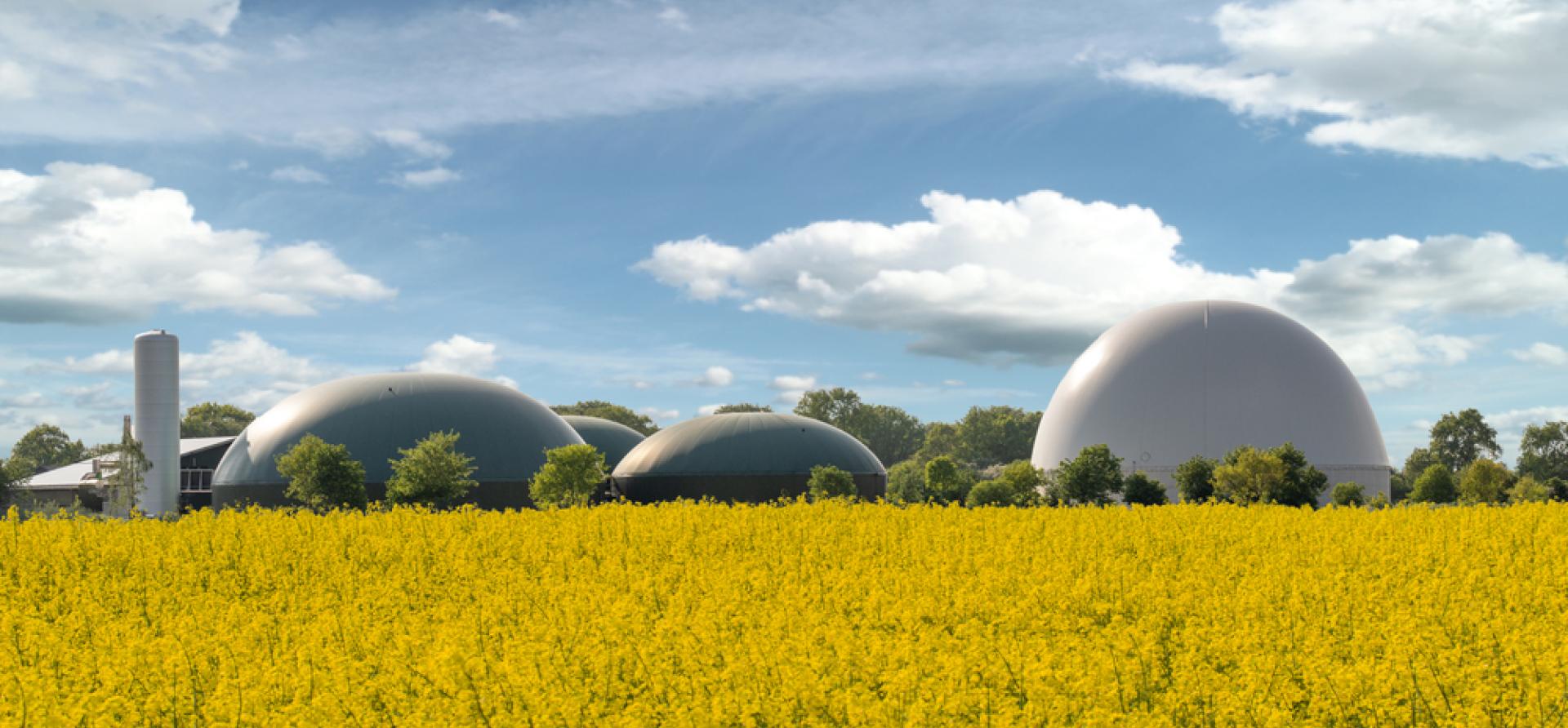Biogas: A possible solution for India’s energy security and decarbonisation goals
Download Full Report
View Press Release

Key Findings
We expect the Indian government’s recent emphasis on biogas to augur well for the sector and help in having clear policy direction and robust market.
India can cut its liquefied natural gas (LNG) import bill by approximately US$29 billion between the fiscal year (FY) 2025 and FY2030 if it manages to replace natural gas consumption with biogas and biomethane incrementally to 20%.
The lack of guaranteed offtake for compressed biogas (CBG) has resulted in its slow adoption as entrepreneurs fear losses in case there are no buyers.
The recent revision of the CBG rate and plans to include a mandate on natural gas marketing companies for 5% CBG procurement, have reignited private sector interest.
Executive Summary
In the last few months, the Indian government has introduced several policy changes to accelerate growth and investments in the biogas sector. It shows the government’s renewed interest in biofuels and biogas, perhaps rightly so. Some recent announcements include the rollout of E20 – 20% ethanol blended in gasoline – from this year, with a target to achieve E20 for overall petrol supply by the financial year (FY) 2026 and the announcement to set up 500 new Waste-to-Wealth plants under the Galvanizing Organic Bio-Agro Resources Dhan (GOBARdhan) scheme. The Ministry of Jal Shakti recently launched a unified portal to make registering biogas projects easier. The portal serves as a one-stop repository for information on investments and projects. At the global level, in partnership with the United States of America (the U.S.) and Brazil, the Indian government has initiated the Global Biofuel Alliance to provide a platform for exchanging knowledge and technologies.
Increasing biogas projects in India is a multi-pronged solution as it will help manage waste, reduce greenhouse gas (GHG) emissions and increase renewable energy production. Using digester sludge from biogas plants as an organic fertiliser will complete a sustainable loop of recycling nutrients back into the soil. Using waste – not food crops – for biogas generation can also help lower GHG emissions. It is important to note that if there are changes in land use for producing biogas, for example, if sugarcane production requires an increase, it will harm the environment as these crops are water intensive and would warrant land use changes. Doing so will negate the purpose of promoting biogas or any other biofuel.
Biogas can substitute natural gas or other fossil fuels with high emissions. Due to its high methane content – 45% to 75% in volume – biogas can be used directly for cooking, electricity and heat. Removing carbon dioxide (CO2) and other impurities like hydrogen sulfide can also upgrade its methane content to 90%, making it equivalent to natural gas in calorific value. This upgraded biogas, also known as biomethane, is a pipeline-ready gas and can be injected into the gas grids as a non-fossil gas. In addition, it can be compressed in cascades and transported like compressed natural gas (CNG) or in cylinders, like liquefied petroleum gas (LPG). Compressed biogas or CBG can directly replace CNG as it has the same composition as natural gas and is compatible with CNG vehicles.
By undertaking the right production processes and plugging methane leakages in the production, upgradation and supply stages, biogas can offer India a cleaner alternative to its dependence on imported natural gas.
We estimate that replacing natural gas consumption with biogas and biomethane incrementally to 20% by 2030 can help India cut liquefied natural gas (LNG) import bills by US$29 billion between the fiscal year (FY) 2025 and FY2030, taking a compounded annual growth rate of 22% in the natural gas sector and based on the assumption of 550 million standard cubic metres per day (MSCMD) of gas consumption in 2030 and varying import prices for each year based on the Japan Korea Marker price forecasts.
If biogas offers so many benefits, why does it have such a slow uptake? Why did we see only 48 CBG plants operationalise in five years under the SATAT scheme instead of the target of 5,000?
The reason is that the biogas and CBG sector lacked a comprehensive market ecosystem in terms of pricing and offtake, it did not have the right incentives and systems for obtaining clearance and permissions were complicated.
The disaggregated nature of government support and financial assistance to the biogas sector was also problematic. Multiple departments and ministries had different schemes and packages for biogas or CBG plants, with the end use defined in some cases and feedstock availability conditions set in others. This multi-department or multi-ministry approach, with everyone working in silos, had resulted in implementation gaps for biogas schemes and the slow uptake of the sector.
In 2021, the government bundled different types of assistance under the National Bioenergy Scheme to enhance the uptake of biogas plants. Moreover, the introduction of the GOBARdhan scheme as an umbrella initiative of the Government of India will help in this consolidation. It covers the entire gamut of schemes/policies promoting organic waste conversion to biogas or CBG.
The lack of guaranteed offtake for CBG has resulted in its slow adoption as entrepreneurs fear losses in case there are no buyers. However, recent policy initiatives, such as revising the CBG rate to reflect the increase in global gas prices and plans to include a mandate on natural gas marketing companies to 5% CBG procurement, have reignited private sector interest in CBG. Co-mingling of CBG in the city gas distribution network would add to CBG’s credibility. Ensuring guaranteed offtake of CBG to producers also requires a take-or-pay arrangement.
Another major challenge in deploying biogas is the varying feedstock and its availability in a usable form. For instance, a biogas plant of 2 standard cubic metres is sufficient to meet the cooking needs of a family of five, but one household does not generate enough waste for that. This calls for biogas feedstock mapping of agriculture and industrial waste to which biogas plants or CBG plants can be linked. This will also prevent the use of food crops for biogas generation. There is also a need to shift from capital expenditure (CAPEX)-based incentives to generation-based incentives to ensure the operability of biogas plants.
Even in the case of biogas slurry, which farmers can use as organic manure, knowledge gaps hinder its use. The market development assistance package to the tune of Rs1,500 per tonne (US$18 per tonne) with an outlay of Rs15 billion (US$180 million) will help overcome some of these barriers and encourage farmers to use fermented organic manures (FOM). Promoting this will lower the fertiliser subsidy burden of the government. As mentioned earlier, the initial cost of 5,000 SATAT plants was estimated to be Rs1.75 trillion (US$21 billion), equal to the fertiliser subsidy estimate for the current FY2024.
The government needs to encourage increased investments and private participation in the biogas sector. It can increase the market viability of CBG and biogas slurry, ensure increased financial access for developing biogas plants and feedstock mapping to ensure the availability of inputs.
Encouraging the participation of private players in the sector will enable robust market development with minimum government support. With the government’s rekindled focus on biofuels, two of the biggest industry conglomerates – Reliance Industries and Adani Group – have already expressed a keen interest in the sector with the announcement to set up 100 and five CBG plants, respectively, in the next five years. As a market starts developing and producers have guaranteed offtake, more private players will show interest.
The government is showing clear intent to develop the biogas sector. Policymakers still need to fill gaps to create a comprehensive market system for the smooth operability of the sector in India. The government needs to encourage increased investments and private participation in the sector. It can increase the market viability of CBG and biogas slurry, ensure increased financial access for developing biogas plants and feedstock mapping to ensure the availability of inputs.
















